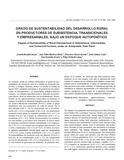Grado de sustentabilidad del desarrollo rural en productores de subsistencia, transicionales y empresariales, bajo un enfoque autopoiético
Fecha
2009-11-09Autor
Palabras Clave
Autopoiésis, Agroecosistemas, Eficiencia energética, Cognición ecológicaAutopoietic, Agroecosystems, Energy efficiency, Ecological cognition
Metadatos
Mostrar el registro completo del ítemResumen
Se comparó, desde un enfoque autopoiético, el grado de sustentabilidad del desarrollo rural en el distrito de Desarrollo Rural 006, La Antigua, Veracruz, México. El estudio se realizó en agosto 2007, mediante entrevistas a 30 productores de subsistencia, 30 transicionales y 20 empresarios, definidos heurísticamente. Los criterios específicos para la selección de productores fueron: Nivel de interacción con las instituciones, diversificación de sus agroecosistemas e innovación de prácticas de manejo. El análisis de eficiencia energética por tipo de productor, mostró diferencias estadísticas (P<0,01), donde el grupo transicional, que son productores de caña de azúcar, fue el más eficiente (4,62 ± 1,4); en comparación con el de subsistencia (2,01 ± 0,7) y empresarial (2,56 ± 0,8). Los empresarios mostraron mayor grado de cognición ecológica (3,01 ± 0,1), en relación (P<0,01) con el grupo de subsistencia (2,65 ± 0,1) y transicional (2,77 ± 0,1), siendo los empresarios los productores más jóvenes y con mayor nivel educativo. El mayor índice de bienestar económico racional correspondió a los empresarios (1,61 ± 0,1) en relación con los grupos subsistencia (1,46 ± 0,09) y transicional (1,52 ± 0,1) (P<0,01). El índice de manejo agrícola sustentable, resultó igual para los empresarios (1,46 ± 0,2) y para el grupo transicional (1,42 ± 0,1). El grado de sustentabilidad del desarrollo rural, fue diferente (P<0,01) y más alto en los transicionales (2,58 ± 0,3), en comparación con los de subsistencia (1,85 ± 0,1) y empresarios (2,16 ± 0,2), lo cual muestra el gran peso del indicador de eficiencia energética en el análisis. Se demostró que hubo procesos autopoiéticos en los tres grupos, solo que la reproducción socio cultural en ninguno de los sistemas está dirigida a lograr autopoiésis para la sustentabilidad. El grupo de subsistencia reprodujo procesos para poder subsistir, el transicional reprodujo su obediencia al esquema agroindustrial y los empresarios se manejaron únicamente por la lógica de la ganancia económica, aun cuando energéticamente fuesen altamente ineficientes.
Colecciones
Información Adicional
| Otros Títulos | Degree of sustainability of rural development in subsistence, intermediate, and comercial farmers, under an autopoietic view point |
| Correo Electrónico | lbustillo@yahoo.com |
| Resumen en otro Idioma | The degree of sustainable rural development in Rural Development District 006, La Antigua, Veracruz, Mexico was compared under an autopoietic view point. During August 2007, 30 subsistence farmers, 20 commercial farmers, and 30 farmers managing operations having both objectives (intermediate to the two extremes) were interviewed. Farmers were selected using three predetermined criteria: level of interaction with institutions, diversity of farm production, and innovation of management practices. The energy efficiency statistical analysis showed differences (P<0.01) among groups, the intermediate group, which are sugar cane growers, was the most efficient (4.62 ± 1.4) than subsistence (2.01 ± 0.7) and commercial operations growers (2.56 ± 0.8). On the other hand, commercial operations growers showed high ecological cognition (3.01 ± 0.1) compared to subsistence (2.65 ± 0.1) and intermediate (2.77 ± 0.1); commercial operations growers were youngest and with higher educational level compared to other groups. The well-being economic index was higher (P<0.01) in the commercial operations growers (1.61 ± 0.1) than in subsistence (1.46 ± 0.09) and intermediate (1.52 ± 0.1). The sustainable agricultural management index was similar between commercial operations (1.46 ± 0.2) and intermediate growers (1.42 ± 0.1). Degree of sustainable rural development, was different (P<0.01) among the three groups, with the intermediate group achieving the most (2.58 ± 0.3), followed by those from commercial operations (2.16 ± 0.2), and subsistence farming (1.85 ± 0.1); this showed the high influence of energy efficiency index. It was found autopoietic process in the three groups; however, none of the socio-cultural reproduction is intended for achieving autopoietic process for sustainability. The subsistence farming group repeat process to survive, the intermediate group reproduced the submission to agroindustry plan, and the commercial operations farmers followed the logic of increasing their income, even thought they are not energy efficient. |
| Colación | 650-658 |
| Periodicidad | Bimestral |
| Institución | Universidad del Zulia (LUZ) Universidad de Los Andes (ULA) |
| Publicación Electrónica | Revista Científica |
| Sección | Revista Científica: Producción Animal |






